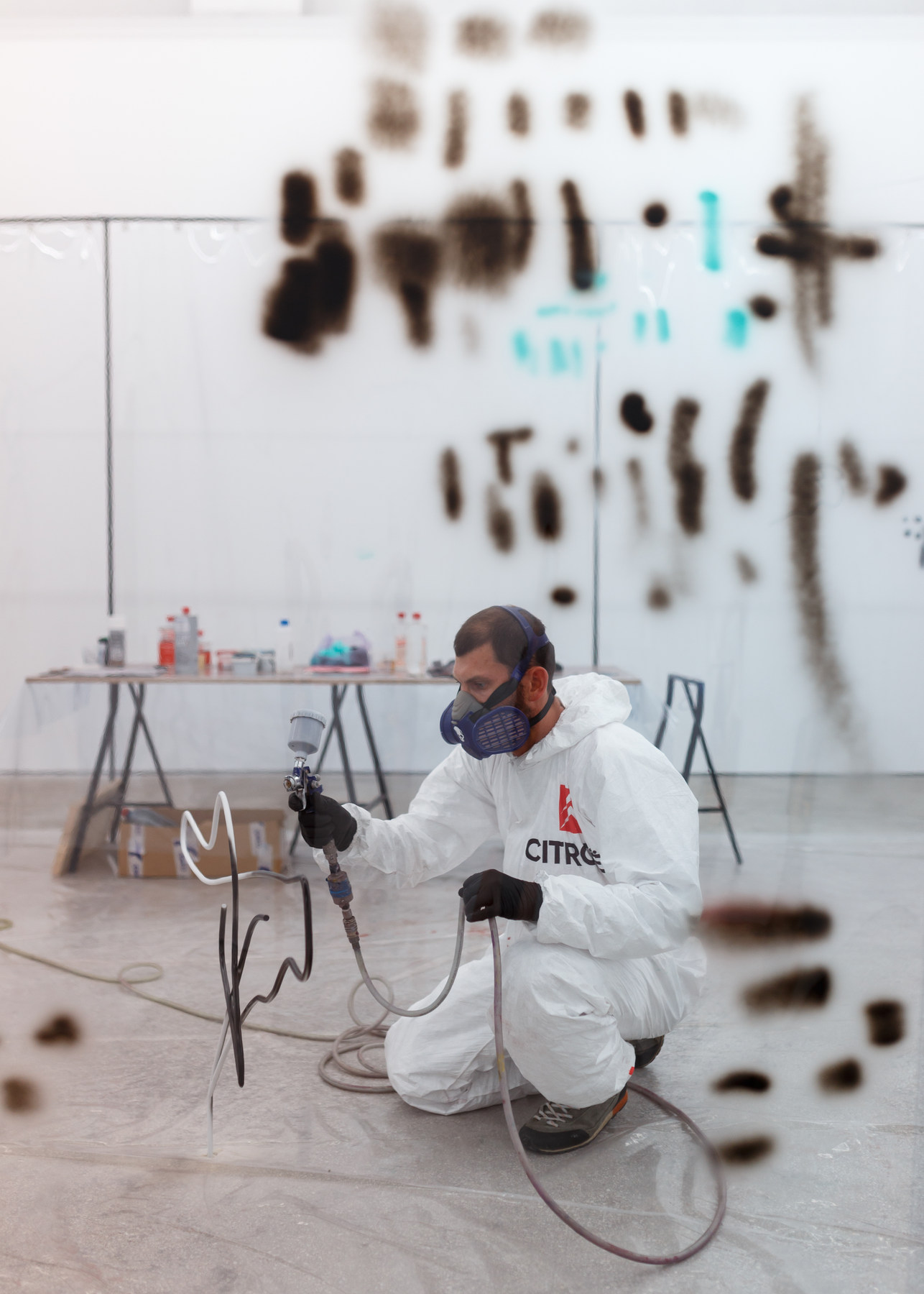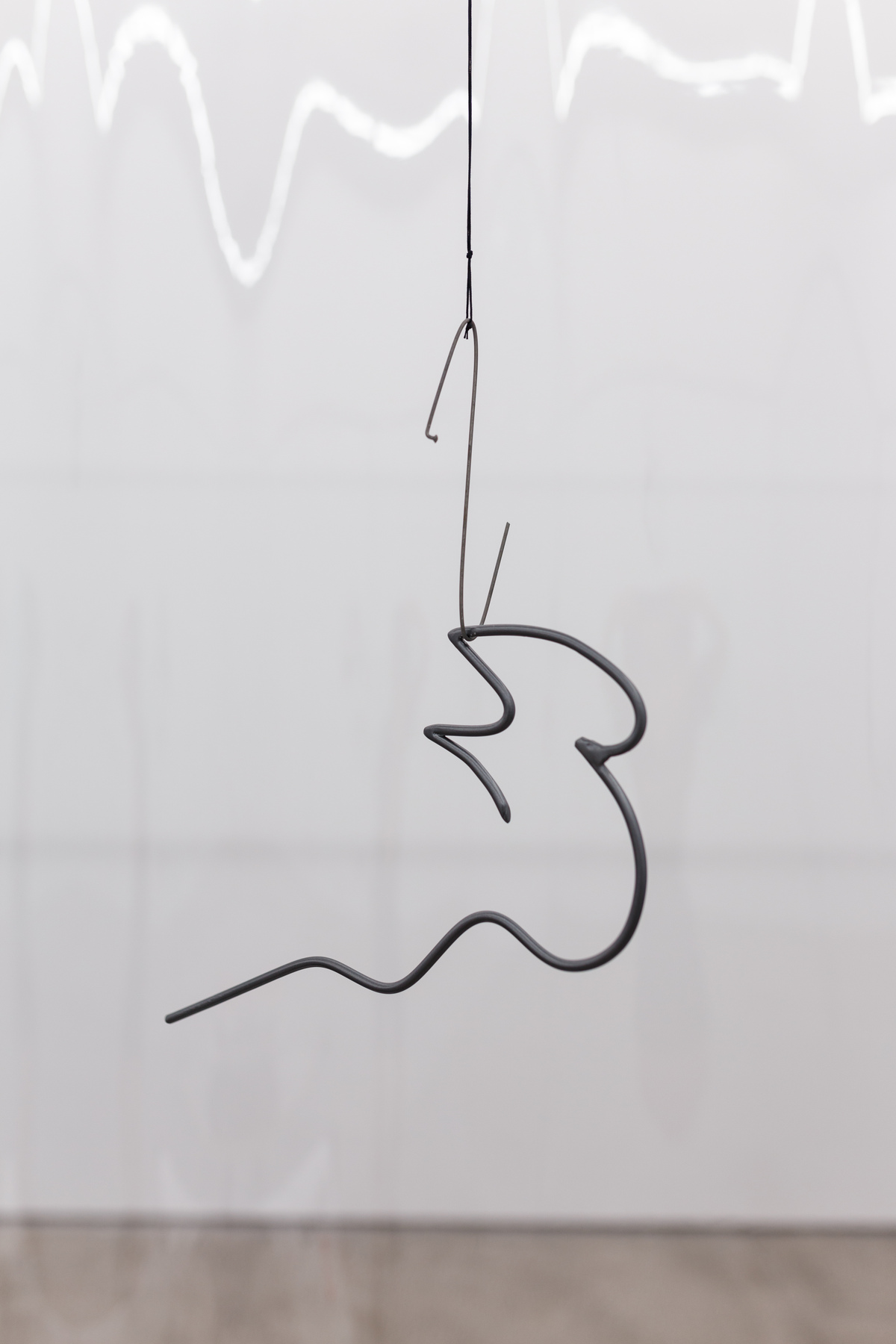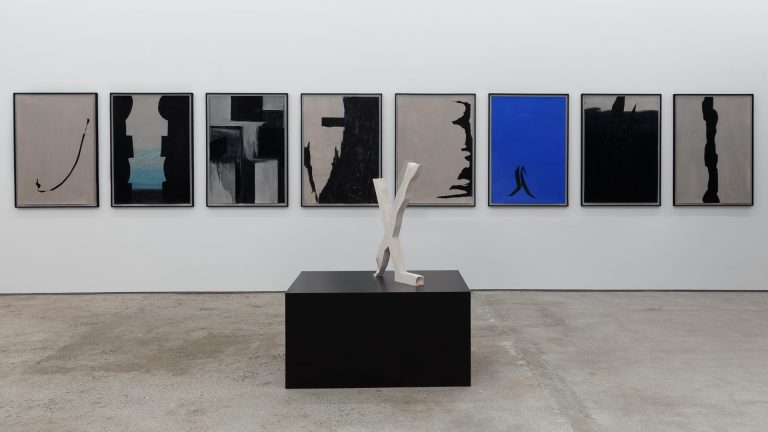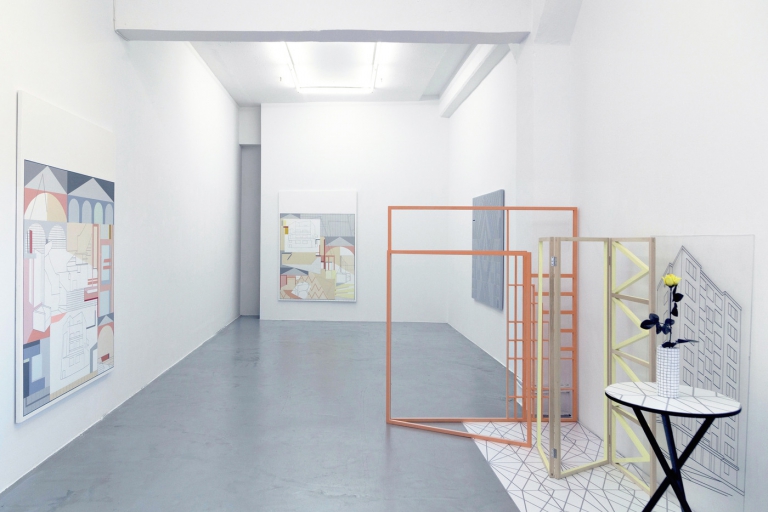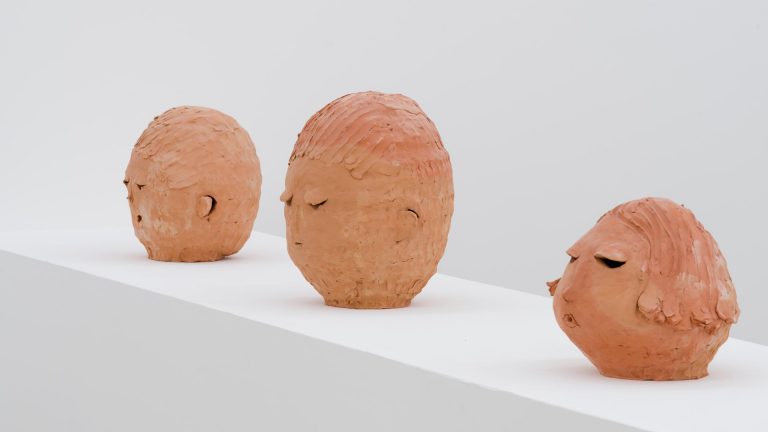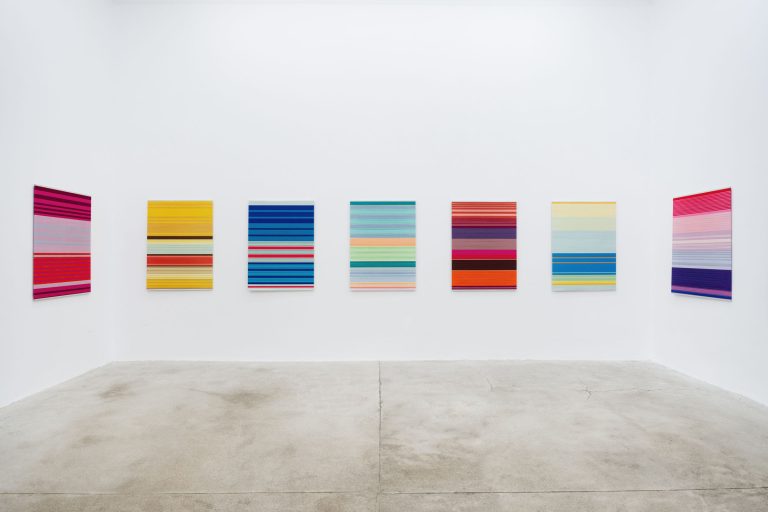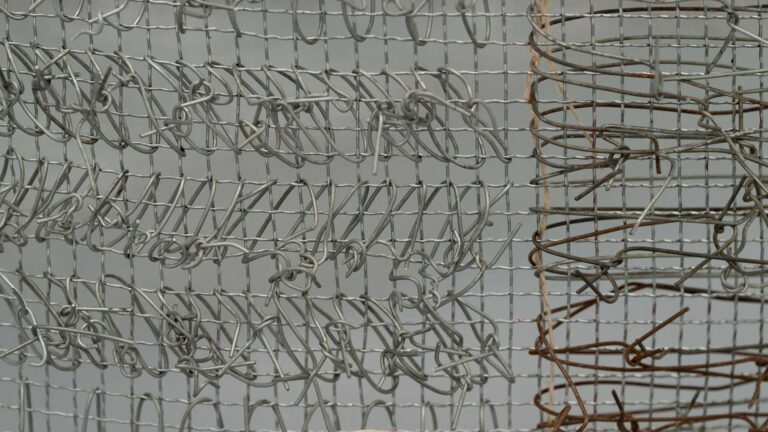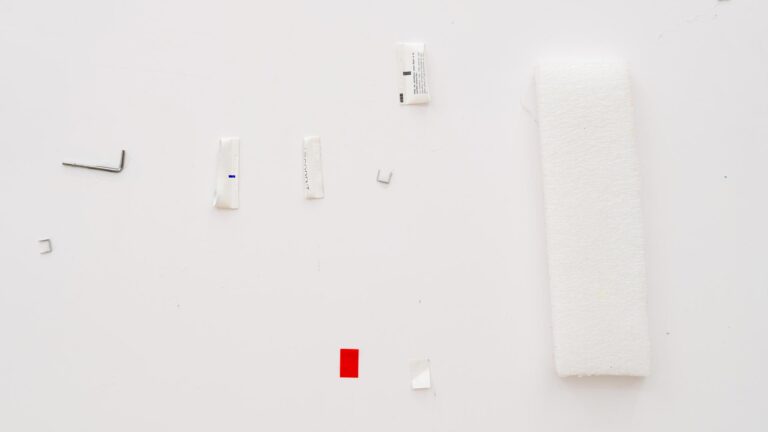Artist: Joe Fletcher Orr
Exhibition title: A Flamingo, a Camel and an Owl walk into a Gallery…
Venue: SABOT, Cluj-Napoca, Romania
Date: August 10 – September 30, 2017
Photography: YAP Studio, all images copyright and courtesy of the artist and SABOT, Cluj-Napoca
A horse walks into a gallery.
“Why the long face?”, the invigilator asks.
…
“I don’t get it,” the horse replies.
by Daniel McMillan
*
In a television ad from 2000, we see robots constructing the new Citroen Xsara Picasso on an automated-assembly line.
It’s the painting stage of the manufacturing process and, while the factory foreman’s back is turned, a rogue machine is taking creative liberties – spraying Picasso-esque doodles over the bodywork.
Spotting the encroaching foreman, the robot quickly erases his work with a spray of grey paint.
A ‘Picasso’ signature below the car’s right wing mirror is the only trace of the machine’s creative endeavours.
As the advert closes, a song echoes over the factory’s PA system.
“Je ne veux pas travailler…”
*
For his first solo exhibition outside of the UK, Joe Fletcher Orr presents a series of metal sculptures.
They are based on line drawings of animals by Picasso. He discovered the animals hanging above his mother’s sitting room sofa; his mother found them in the home decoration section of IKEA, in a frame named OLUNDA.
The observant viewer, noticing the industrial plastic curtains that separate the sculptures, may already be forming connections between the production of Orr’s objects and industrial manufacturing.
It’s certainly an association the artist wants us to make. The drawings have been made ‘life size’, fabricated in steel, sprayed by professional bike painters during the opening, then completed during the exhibition. The colours have been selected from the first ever range of Citroen Picasso colours (1999).
But, in drawing a comparison between the production of art and mass-manufacturing, what are the artist’s aims?
It doesn’t take great powers of deduction to realise the artistic legacy of Pablo Picasso and Citroen’s people carrier have little in common.
There are certainly no visual qualities inherent in the design of the vehicle that recall the work of the artist. And even the most devious marketer would struggle to feign links between the world view of Picasso, a member of the French Communist Party from 1944 until his death, and that of the European automotive conglomerate.
In the marketing campaign behind the Citroen Xsara Picasso, the artist’s name is appropriated for the qualities associated with it. ‘Picasso’ is used, quite literally, as a badge. A signifier of good taste, high culture and superior quality. It imparts value.
The licensing of the Picasso ‘brand’ to flog an economy family MPV, led to inevitable squabbling amongst the family. Picasso’s granddaughter, Marina, filed an unsuccessful law-suit against Claude, Picasso’s son and administrator of the estate, for his sale of the signature to Citroen.
Questioned by the New York Times in 1999, Claude’s lawyer explained the licensing of the logo “underlines the estate’s strategy of associating the Picasso name with high-quality products.”
The artist as a brand. Art and commodity. Signatures and trademarks.
This is not new territory for Joe Fletcher Orr.
In a work for a group show at Frutta Gallery in Rome (“The Game”, 2014), he invited the participating artists to sign a football. The resulting object sat on the gallery floor amongst the other artists’ contributions.
Would the football have been worth as much money if the artist had failed to acquire the autographs of the exhibition’s ‘big names’? Probably not.
But, had an artist refused to sign the ball, we would be hard pressed to say the object didn’t carry the same intrinsic value as an artwork.
Here, Orr revealed that an object’s monetary worth and artistic value are not always equivalent.
The Citroen Picasso ad plays on ideas of work avoidance and mischief. The machine is engaged in creative play when it should be labouring. It is a marketing company’s idea of ‘the artist’. Non-conformist. Anti-authority. A free spirit.
‘Non-conformity’ is an ironic virtue to associate with a mass-produced economy automobile, yet it is precisely this quality that Euro RSCG Wnek Gosper, the advertising agency behind the ad, wished to align the car with. Why?
Let’s compare it to an advertisement for a similarly priced family MPV which the Xsara Picasso was in direct competition with. In a 1999 ad for the Renault Scenic, we see an attractive woman and four healthy children leave the car, hold hands and frolic through meadows in an apparent homage to ‘The Sound of Music’. The handbrake has been left off and the car rolls gently down the hillside…
Unlike the Renault ad, which plants the vehicle in an idealistic picnic-like setting, the Citroen ad seems to take us ‘behind the scenes’ of the assembly process. The ad’s industrial setting, and its portrayal of a renegade painter resisting its role as a mere labourer, would certainly have created a striking contrast if it followed the Renault ad during an advertisement break.
In the marketing of the Xsara Picasso, ‘the artist’, and its associative qualities of freedom and individuality, are used to distinguish it from other products on the marketplace.
There is, like the machine in the Citroen ad, a sense of mischief in the work of Orr.
For his first solo exhibition (“Under the Thumb”, The International 3, Manchester) the artist created a series of visual puns, one-liners and pranks. ‘Jokes sold here’, the viewer was informed by way of a sticker on the door leading into the gallery.
How might the art world intelligentsia muse over these works?
When we evaluate an artwork we do so under the guise of arts criticism. But while critical analysis of an art work might further our appreciation of it, the same deconstruction of a joke has an inverse effect; that is, in explaining why something is funny, we drain it of humour.
Like a joke, you either ‘got it’ or didn’t.
Humour was used as a form a resistance against the pretensions of the artworld.
Reflecting on Orr’s anarchic humour, I am reminded of a conversation in which he discussed his first performance.
A school boy, the young artist ate an apple from a still life arrangement in painting class, to the bewilderment and disapproval of his art teacher (‘the institutional critique’, it seems, was not an accepted form of artistic expression at secondary-level art education).
“Ceci n’est pas une pomme”, the action seemed to infer.
Or perhaps simply, “Je ne veux pas peindre…”
*
In a photograph from the late 50s, we see a young man stood by a Citroen DS.
The man is Manuel Mejido, a Mexican journalist living in France. The location: Picasso’s villa in Cannes.
Mejido is gesturing towards a painting on the side of the car. It is, according to the journalist, ‘The wreaths of peace’ – a work by the great Pablo Picasso, painted onto the reporter’s motor while visiting the artist’s villa for an impromptu interview.
In need of money, the journalist was forced to sell the car.
‘The wreaths of peace’ goes uncredited in catalogues of the artist’s work, and the whereabouts of the vehicle remain unknown.
Perhaps the work lies in storage, in the vault of a private collector. Or perhaps it is parked in the garage of an unwitting classic car aficionado, resprayed in its original sky blue.
A ‘Picasso’ signature above the left wheel arch is the only trace of the artist’s creative endeavours.
———————————————————————–
Daniel McMillan is an artist and writer based in Manchester.











